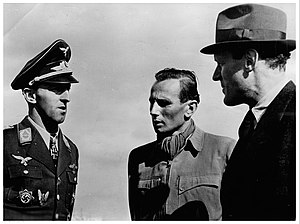Hermann Graf | |
|---|---|
 Hermann Graf (left) with Willy Messerschmitt (right) and Fritz Wendel | |
| Born | 24 October 1912 Engen, German Empire |
| Died | 4 November 1988 (aged 76) Engen, West Germany |
| Buried | City cemetery in Engen |
| Allegiance | |
| Service | |
| Years of service | 1936–1945 |
| Rank | Oberst (Colonel) |
| Unit | JG 51, EJGr Merseburg, JG 52, JG 50 and JG 11 |
| Commands | JG 50, JG 11, JG 52 |
| Battles / wars | World War II |
| Awards | Knight's Cross of the Iron Cross with Oak Leaves, Swords and Diamonds |
| Spouse(s) | Jola Jobst (1944–1949) |
| Other work | Salesman |
Hermann Graf (24 October 1912 – 4 November 1988) was a German Luftwaffe World War II fighter ace.[Note 1] He served on both the Eastern and Western Fronts. He became the first pilot in aviation history to claim 200 aerial victories—that is, 200 aerial combat encounters resulting in the destruction of the enemy aircraft.[2] In about 830 combat missions, he claimed a total of 212 aerial victories, almost all of which were achieved on the Eastern Front.
Graf, a pre-war football player and glider pilot, joined the Luftwaffe and started flight training in 1936. He was initially selected for transport aviation but was subsequently posted to Jagdgeschwader 51 (JG 51—51st Fighter Wing) in May 1939. At the outbreak of war he was stationed on the Franco–German border flying uneventful patrols. He was then posted as a flight instructor stationed in Romania as part of a German military mission training Romanian pilots. Graf flew a few ground support missions in the closing days of the German invasion of Crete.
Following the start of Operation Barbarossa, the German invasion of the Soviet Union, Graf claimed his first aerial victory on 4 August 1941. He was awarded the Knight's Cross of the Iron Cross after 45 victories on 24 January 1942. It was during the second summer of the eastern campaign; however, that his success rate dramatically increased. By 16 September 1942 his number of victories had increased to 172 for which he was honored with the Knight's Cross of the Iron Cross with Oak Leaves, Swords and Diamonds. At the time of its presentation to Graf it was Germany's highest military decoration.[Note 2] On 26 September 1942 he shot down his 200th enemy aircraft.
By then a national hero, Graf was withdrawn from combat operations and posted to a fighter pilot training school in France before being tasked with the setting up of a new special unit: Jagdgeschwader 50 (JG 50—Fighter Wing 50). Its mission was as a high-altitude unit to intercept the de Havilland Mosquito intruders. In November 1943 Graf returned to combat operations. He was appointed Geschwaderkommodore (Wing Commander) of Jagdgeschwader 11 (JG 11—11th Fighter Wing) and claimed his last and 212th aerial victory on 29 March 1944. He was severely injured during that encounter and, after a period of convalescence, became Geschwaderkommodore of Jagdgeschwader 52 (JG 52—52nd Fighter Wing). He and the remainder of JG 52 surrendered to units of the United States Army on 8 May 1945, but were turned over to the Red Army. Graf was held in Soviet captivity until 1949. After the war he worked as an electronic sales manager and died after a long illness in his home town of Engen on 4 November 1988.
- ^ Spick 1996, pp. 3–4.
- ^ Obermaier 1989, p. 21.
- ^ Williamson & Bujeiro 2004, pp. 3, 7.
Cite error: There are <ref group=Note> tags on this page, but the references will not show without a {{reflist|group=Note}} template (see the help page).